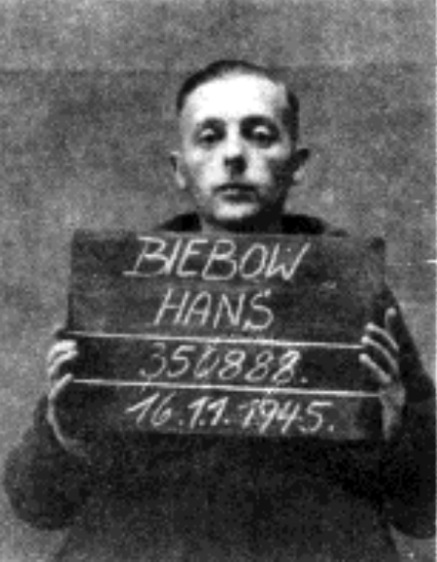Hans Biebow
Following their invasion of Poland, the Nazis decided to create ghettos in major cities in which they force the Jews to live. One of the largest of these ghettos was in Lodz and the role of overseeing all of the manufacturing work carried out within ghetto was given to senior Nazi officer Hans Biebow.
Born on 18 December 1902, Biebow was recognised as a skilled administrator by those high up in the Nazi Party.
Having taken charge of the ghetto in late 1939, Biebow soon realised the potential to making Lodz Ghetto a profitable venture for the Nazis. He believed that if the ghetto was essentially turned into a slave labour camp then the Jews could assist the Nazi war effort with valuable manufacturing.

During his time in charge of the ghetto, he established himself as a ruthless administrator and he also oversaw tens of thousands of Jews being deported to death camps such as Auschwitz and Chelmno.
As head of the Lodz ghetto Biebow worked closely with Chaim Rumkowski who had been appointed as the leader of the Jewish Council, which was a council created by the Nazi to help govern the ghetto. The pair developed a strong working relationship, so much so that Rumkowski has been seen as a controversial character, with debate still raging on about whether he was really trying to help the Jews, the Nazis or himself.
Rumkowski and the Jewish Council established 117 different workshops within the Lodz Ghetto. These workshop used the Jews as slave labour to help manufacture military equipment that would be used on the front lines by the Germans. The Jews were promised food and medical supplies by Biebow in return for their work in the workshops (although evidence suggest that Biebow did not stay true to his world). Rumkowski also attempted to get the Jews on side by telling them that working in these manufacturing shops was their best chance of survival.
Biebow was directly responsible for starving the ghetto's population beyond limits of endurance. Despite suffering from starvation, which killed many, the Jews in the ghetto worked tirelessly and turned over a large profit for the Nazis. At his trial at the end of the war it was shown that Biebow had profited massively from the ghetto, with evidence showing that the Nazi officer took and sold properties from the Jews, pocketing the money.
The ghettos created by the Nazis were not purely to keep the Jews and put them to work - they were mainly used as holding pens, with people shipped out in their thousands to the nearest concentration camps where they would be killed and the cycle repeated. Indeed, during his time at the Lodz Ghetto Biebow oversaw thousands and thousands of Jews being deported to the Auschwitz and Chelmno death camps. As many as 204,000 Jews, as well as some Roma gypsies, were living within the ghetto when it was at its peak - just 10,000 of these survived.
Like most Nazi officers towards the end of the war, when it became clear that the Germans would lose Biebow fled. At first, as the Red Army made quick progress from the East and headed towards Lodz he went back to Germany. By the end of the war he was in hiding but was later spotted and arrested.
In April 1947 Biebow was made to stand on trial charged with crimes against humanity during his time and the head of the Lodz Ghetto. He used the same argument as many senior Nazi during their post-war trials, stating that he was just ‘obeying orders’. But, like most, this was dismissed and he was found guilty and sentenced to death.
Biebow was reportedly hanged on 24 April 1947.
See also: The Bialystok Ghetto
MLA Citation/Reference
"Hans Biebow". HistoryLearning.com. 2024. Web.
Key facts
| Name: | Hans Biebow |
| Birth Date: | 18 December 1902, |
| Death: | 24 April 1947, |
| Occupation: | Chief of German Nazi administration of the Lodz Ghetto |
